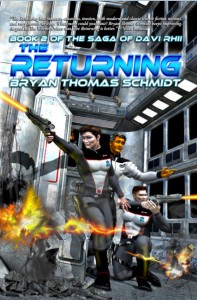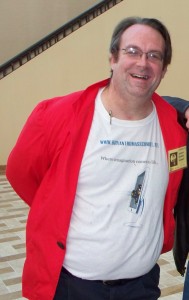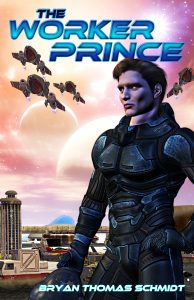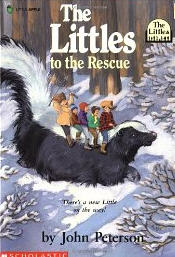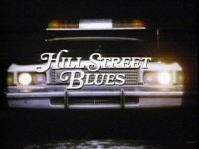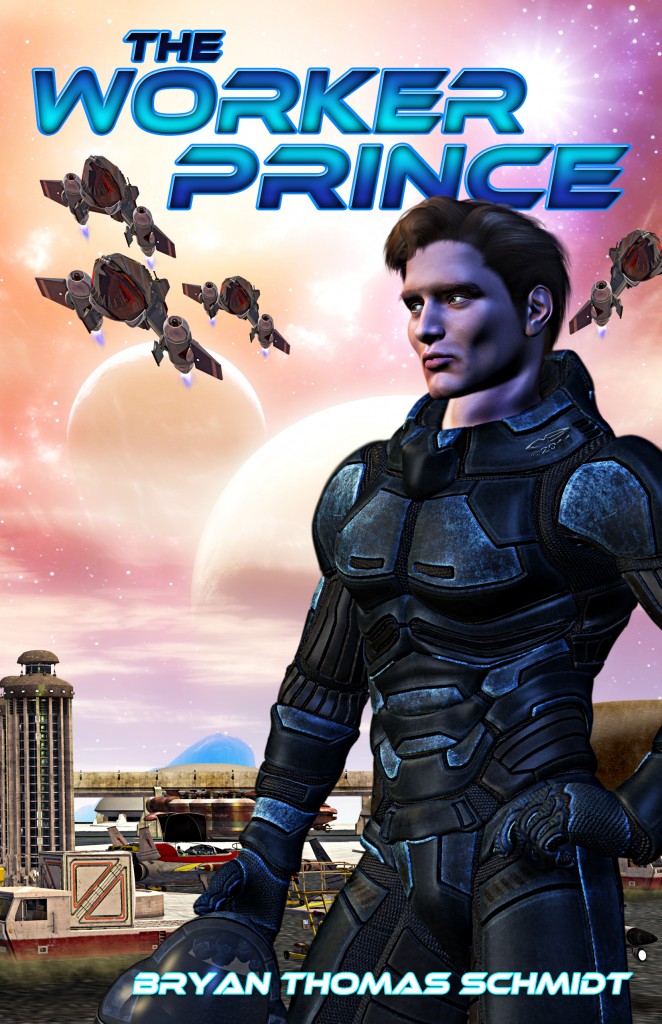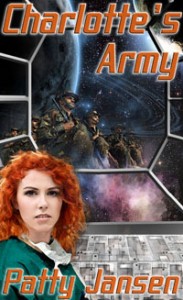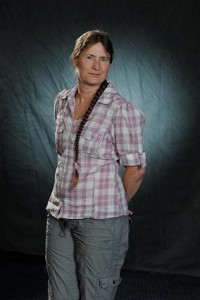My friend and fellow editor Kat Heckenbach asked an interesting question on Facebook today which really got me thinking about stereotypes: Are authors obligated to make characters fall into certain stereotypes because readers expect it? (For example, most people think of Goths as angry, snarly, dark, and Poe-obsessed. But when referring to a little kid, they can and do use the word cute–but if a Goth character in a book said that, would it just throw you right out?)
Stereotypes are common in literature, there’s no doubt, and in Science Fiction and Fantasy this can be particularly the case, especially with female characters. Damsels in distress are a mainstay of our genres, both inside the stories/books and on the covers. Most of us have seen Jim C. Hines’ posts about the silliness of the way women are posed versus men in such art. These images feed the stereotypes. Yes, they are an attempt by publishers to sell books using sex, which has worked forever as a means of moving product, not just books. But what message do they send culturally to women, young women and, almost more importantly, men, about the roles women have to play in our society? Are they just objects for lustful stares and wet dreams? Do these images leave open the possibility for far more substance below the surface? How silly do male characters look when dressed and posed like female characters typically are? Take a look at this imagining or Avengers with such poses.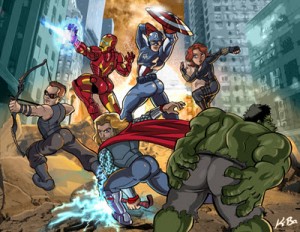
Think I’m kidding? Take a look at two cover examples below. One is an older example, the other more recent. Do artists and publishers actually think anyone could fight dressed this way or would? It kind of questions the character’s intelligence, doesn’t it? To make it worse, in the case of Ringo’s book, the publisher site describes the character as “soccer mom and demon fighter.” Wow. A soccer mom who walked around in that outfit would be accused of indecency, wouldn’t she? Not to mention being shunned by fellow soccer moms.
For me there’s no question that bucking stereotypes is far more interesting and adds nuances. If you start out with the typical housewife who raises kids while the hubby works but then turns out to be a zombie fighting badass, how much more interesting did she just get? I think, in particular, with women characters, fantasy struggles with this. The traditional epic fantasy has strong, sweaty fighting men protecting their helpless women, but is it really that interesting anymore? And can’t we change our views of women enough to include more possibilities? Even history would demonstrate that women have played far more diverse roles than the stereotypes a male-dominated society describes them with. There has been at least one female Pope, for example, whose gender was only discovered after she became pregnant. That was hundreds of years ago and she had to conceal her identity. But this is a different age. Why should women have to hide their true selves? I’d like to think we’re more enlightened than that, but I know not all of us are.
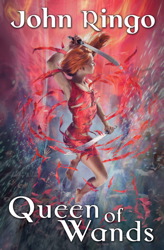


There’s a ridiculous term if I’ve ever heard one: “women’s work.” The work typically grouped under that heading is the work necessary to daily living. If you’re a bachelor, unless you’re rich, you’re going to have to do laundry, find a way to cook and eat, etc. It doesn’t make you suddenly sprout breasts and start generating estrogen. “Women’s work” is an insulting term because its origins come from a sense of superiority by men that the “important work” is not for women. Because, of course, raising good, responsible citizens while the men are at the office working sixty hour weeks is unimportant. Keeping a nice home so the man can come home and actually relax during down time is menial. We’d all survive without those things, right? Yep, without “women’s work” we’d still be the greatest country on Earth.
Hardly. Some of the most meaningful character-building times in my life were working with my mother and grandmothers on the very tasks typically called “women’s work”—learning to cook, fold clothes, sew, etc. I’m a creative after all, and cooking and sewing, in particular, very much stimulate my creative impulses. Add to that the fact that walking around naked outside of performance art has tended to be frowned upon, especially if your ribs are showing like a starving African kid, and, well, they really did me a service teaching me to care for clothes and feed myself. I’m just saying…



You just can’t stereotype women any more than you can men these days. The fact is that we are all individuals and just when you meet a women whom you think embodies all the “typical female traits,” five minutes later she’ll surprise you with aspects you never would have imagined. It used to be “men’s work” to get an education and write, for example, and where would our genres be without Ursula LeGuin, Connie Willis, Kristine Kathryn Rusch, A.C. Crispin, Leigh Brackett, C.L. Moore, and numerous others? How much would be have missed out on if the Cat Valentes, Kij Johnsons, Nnedi Okorafors, and N.K. Jemisons had never put pen to paper? Seriously. What about Ellen Datlow and Paula Guran, Beth Meacham and Liz Gorinsky, Anne Vandermeer and Sheila Williams? They buy stories from men as well as women and all are amongst the top editors in this business.
I get the whole male instinct to want to protect their women. But it’s not like those instincts don’t also exist in women. Think I’m wrong? Go to a playground and act weird around some woman’s kid. Be sure and take a picture of that black eye and get a copy of the mug shot, too, okay?
I think it’s incumbent upon all writers, male and female, to carefully consider the roles they give to characters. Yes, with minor roles, sometimes stereotypes can be expedient. And sometimes they get the job done, but push yourself to make sure that for every stereotype you employ ten characters who buck such narrow definitions. Not only will your plots and themes and work expand in scope and meaning as a necessary result, but it will resonate more profoundly with modern readers and even help erase stereotypes as functions of our culture. I can think of no greater goal and contribution Science Fiction and Fantasy writers could make, can you?
The world needs more ninjas posing as suburban housewives who save the world. It needs more mothers who don’t wait for their husbands to save the day but draw their sword or blaster and take on the kidnappers themselves, kicking ass to free their kids. Our modern world has plenty of room for men in the kitchen and sewing, too. After all, think of Top Chef and other cooking shows: Emeril Lagasse, Wolfgang Puck, Curtis Stone, Gordon Ramsey, Calvin Klein, Bob Mackie, and Guccio Gucci—should these men be considered abnormal for the excellence they’ve worked hard to create? Hardly.
As much as I applaud them for having this panel, it’s 2012. Should we really still desperately need panels like this:
(PR) Kicking ass in high heels: These days women can kick ass, save the world, and still have time to fall in love.
But why are they still doing it in hot pants and high heels? Can heroines be a size 18 and still be beautiful?
Unfortunately, we do need them, and it’s because of the perpetuation of stereotypes. Think of the other issues we could be putting our time into if we just put aside these silly limitations and moved on?
One of the worst insults I got in a review was a review which said I had “shockingly outdated female roles.” This was for a story where I have female political leaders, female starfighter pilots, female warriors, female military leaders, and so on. I thought I was trying hard to break the molds, and yet here comes a reviewer to tell me I hadn’t done enough. I still think they’re wrong, but, at the same time, it pushes me to strive harder, to ask more questions, and to do everything I can to prove them wrong so I never hear such a disappointing criticism again. After all, my Mom reads my books. I don’t want her thinking I didn’t learn a thing from all her efforts. But more than that, I don’t want my daughters and other girls who read my books to ever think I’m telling them they can’t be anything they want to be.
The world may set limits, but in the worlds of your fiction, possibilities are limitless. Don’t let yourself write within the familiar box of the world in which you live. Instead, tear down the walls and shoot for something no one’s seen but should be seeing. Push the boundaries and see where it takes you, your characters and your story. Let no one accuse us of writing the same old fantasy or space opera. Instead, let us together launch a new age and work to redefine what “same old” is. To my mind, we owe it to our wives, mothers, sisters and daughters to open the world’s doors. After all, making the world a better place is a responsibility for all of us, not just a “chosen male few.” We live in an age when the distinction between what women can do for careers and what men can do is fading to almost nothing. How can our fiction represent our times and a bright future if it doesn’t reflect that?
For what it’s worth…
